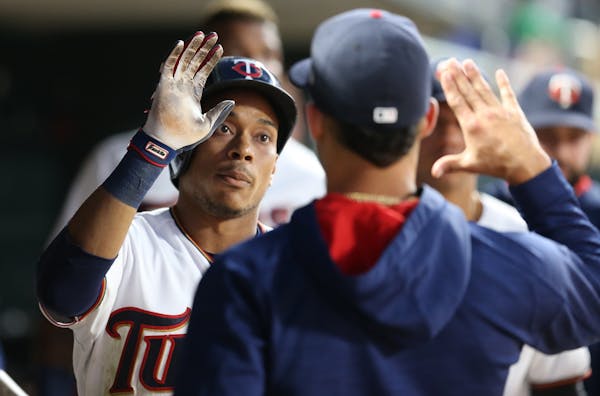The Twins just made a trade almost guaranteed to anger their fan base and bolster stereotypes about their self-imposed financial restraints.
They dealt one of their best trade chips, second baseman Jorge Polanco, to the Seattle Mariners for a bottom–of-the-rotation starting pitcher, a quality reliever, one top outfield prospect and one intriguing pitching prospect. They also received cash.
This is not the magic bullet trade that many fans would have liked: a hitter-for-pitcher trade like the one baseball boss Derek Falvey made last winter.
That deal was popular batting champion Luis Arraez for Miami pitcher Jorge Lopez and two prospects. Remember, that trade was highly unpopular even though it brought back a pitcher who had a chance to become an ace. Then, he became an ace, justifying the deal even before we know whether the prospects will add value to the deal.
This deal did not bring back anyone like Lopez. The biggest name among the four players the Twins received is veteran righthanded starter Anthony DeSclafani. He figures to slot into the fifth spot in the rotation.+
DeSclafani is not an exciting addition. He has had good seasons and bad seasons, and he is coming off an injury and a 4.88 ERA. Look inside his numbers, and he likely projects to be a functional modern starter, meaning he should be able to give the Twins five competent innings.
Again: That is not exciting.
Despite DeSclafani's underwhelming résumé, here are seven reasons why this deal makes sense, and could wind up being a winner for the Twins in the long run:
1. Falvey's hands are tied financially. Until and unless the Twins land some television money, he will need to keep the prospects and young players he believes will be high-value, low-cost members of the roster.
Trade infield prospect Brooks Lee? Not going to happen, not unless the return is stunning. Lee could be a high-impact player and he will be affordable and under team control for six big-league seasons.
That's why trading Polanco made sense. He's due to make $10.5 million, and while he was valuable as a professional hitter willing to play anywhere and every day, he has been nagged by a series of injuries and will turn 31 this summer.
He also wasn't valued enough by the market to bring a true No. 2 starter in return, and trading him gives Falvey some financial flexibility.
2. Edouard Julien and Brooks Lee will be in the lineup for years. One of them will play second base. The other could move to another position or become a super-utility player who can hit and play virtually every day. Polanco was superfluous.
Last year, Polanco started the season as the Twins' second baseman. He had 343 plate appearances and a .789 OPS. Julien was called up during the season. He had 408 plate appearances and an .839 OPS.
Julien is already a more impactful hitter than Polanco, and he's just figuring out big-league pitching. If the Twins can get him to be an average fielder, he will be a star.
3. DeSclafani does not replace Sonny Gray, who was brilliant for the Twins last year as a true No. 2 starter. But let's remember what Gray produced in terms of team victories and losses. The Twins were 14-19 in his starts in 2023. He also threw the pitches that essentially ended the Twins' postseason.
DeSclafani won't replace Gray's dominance. With run and bullpen support, he could wind up contributing to more team victories than Gray did last year.
4. DeSclafani may wind up being the third-best pitcher and fourth-best player among the Twins' acquisitions. Reliever Justin Topa adds to a remarkably talented group of relievers, and he gives the Twins a chance to have one of the best bullpens in the game. Outfield prospect Gabriel Gonzalez was one of the Mariners' five best prospects and, along with Walker Jenkins and Emma Rodriguez, gives the Twins three outfield prospects who could become stars. Pitching prospect Darren Bowen is less highly rated but promising.
5. The Twins are more likely to build, now and for the foreseeable future, through trades, drafting and player development rather than through free agency. Adding a top prospect and an intriguing prospect adds to their reservoir of organizational talent, and you need that kind of talent to make trades during the offseason and at the trading deadline.
6. If the Twins haven't had "The Talk'' with pitching prospect Louie Varland, he should be able to read between the lines of this deal. They chose an average veteran as their fifth starter instead of handing him that job. They're telling him that the best way for him to be a big-leaguer and help the team right now is to be a dominant reliever, not a middling starter. Varland has a chance to be an All-Star setup man and future closer.
Imagine this bullpen: Jhoan Duran, Griffin Jax, Brock Stewart, Varland, Caleb Thielbar, Topa, Jorge Alcala, Jordan Balazovic and Kody Funderburk. Duran, Stewart and Varland (out of the bullpen) are capable of the kind of sheer dominance that can turn a 3-2 lead in the sixth inning into an automatic victory.
7. By adding to the big-league roster and prospect reserves, this deal creates the possibility of more deals.
This is not the kind of instant-gratification trade that makes fan bases rejoice. But then neither was the Arraez-Lopez trade, and that one worked out quite well for the Twins.

Souhan: What other pro leagues can learn from NHL's successful All-Star break
Souhan: Leaving ESPN is a bad idea for Major League Baseball

Souhan: What Finch must do for the Wolves to win

Souhan: Jessie Diggins and the author telling her story


